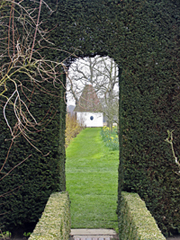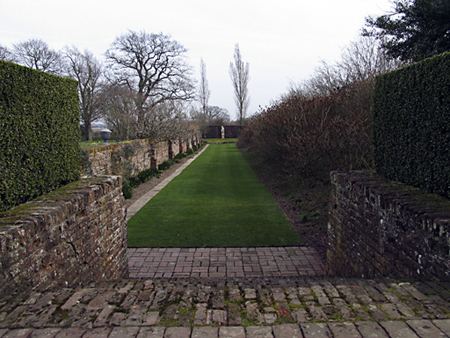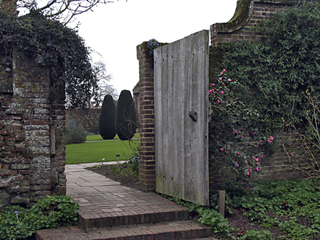Human Flower Project
Saturday, March 08, 2008
Sissinghurst: Now I See It. Now You Do, Too
The “invisible” Vita Sackville-West made a garden that launched ten-thousand gardening visions, John Levett’s among them. Ever thanks to you, John.
 Essay and photos by John Levett
Essay and photos by John Levett
Connections.
I’m sitting listening to Somethin’ Else, Cannonball Adderley’s 1958 outing for Blue Note which just happens to have Miles in the band which might just happen to have sold a few more copies. It’s nothing remarkable, no doubt filled contractual obligations, kept the band off the streets and, skipping past a few concepts and events that I can only half make up, reminded me of Coltrane’s Live at the Village Vanguard, which broke up the band. Our band. That’s Stuart, Mick & Me. And the bloke who could play.
There’s nothing more certain to break up a band than drafting in someone who took all the lessons, got the certificates, could read the notes, follow the tune then throw it away, create a signature style and show the rest of us that we’re only water-carrying shufflers for the Paul Whiteman orchestra. Our band had dosed on King Oliver, Kid Ory, George Lewis and Johnny Dodds solos so why we let in a jump-jive sax player I can’t fathom. Whatever. History was against us. Lennon etc. were playing Hamburg. British Beat was only months away. And I’d already bought ‘Live,’ started collecting Coltrane, going to Joe Harriott gigs in south London, staying up late at wherever Tony Oxley [I think] was playing, then kipping on a bench on Charing Cross Station waiting for the first train out to the suburbs on Sunday morning.
Which reminded me of sitting in the back seat of a mate’s car driving down to Sevenoaks in Kent one Friday evening in 1968 and sitting next to this bloke I’d never met who asked me who I read (Orwell), who I listened to (Coltrane), who I watched (Antonioni) and so did he. We became friends for twenty years until I changed and he didn’t. In those decades he came to teach teachers, I taught kids & together we worked on learning projects for schools. Which took us to Knole House.
We asked for and got the necessary permissions to photograph the interiors of the house; being taken around by the jolly Baron Sackville who moved furniture, rearranged settings to get the best light, gave us tea and buns, access to the family photo albums and a catalogue of anecdotes. We filled our boots that day but I moved out of south London shortly afterwards and returned to Knole only some thirty years later when I thought it a good idea to take myself down there to sit in the grounds to read Woolf’s Orlando.
The Baron Sackville (who was either a Bertram, Bernard or Lionel) came to Knole as a result of the custom of primogeniture whereby all the family stuff goes to the firstborn male or, if there isn’t such a male, so on down through the family until they get one. If you’re a firstborn female then you’re invisible. Which is why Vita Sackville-West, of the same family, got the hoof, packed the mattress on the truck and headed someplace else.

Or, finally, to Sissinghurst in 1930. There were a few stops on the way but I always think that they don’t count. There’s every reason to believe that Vita was happy at Knole and bitter, if not resentful, at having to leave it. In circumstances such as that it’s not unreasonable to seek to recreate, if not the happiness, then at least the circumstances in which it might return. I’m inclined to believe that the creation of Sissinghurst was a reasonable bash at doing just that.
There are still points on the Weald of Kent (Biggin Hill, Emmetts near Westerham, Churchill’s Chartwell, the tower at Sissinghurst) where you can believe that this was England as it once was. Which it wasn’t. It once had a thriving Mediaeval iron and charcoal industry, and forests, decimated by the said industry and Tudor demand for shipbuilding. What you can see now was created by the enclosure acts and the demand for wool. Nevertheless, Kent still passes as what you might like to think of as ye olde England; I’d happily live there and fantasize too if I could go back a century prior to stockbroker gated communities.
A couple of years ago I chanced on a first edition of Vita’s The Land and bought it for no other reason than that I thought it yet another good idea to take myself down there to sit in the grounds and read it. I’m not alone in thinking it a good idea to read originals in original settings. I’m also not alone in knowing that this is a romantic conceit. At the end of the poem is the dateline ‘Ispahan, April 1926.’ Ispahan is a bit of a schlep from the Weald but why let a continent and a half get in the way of imaginings. ( I once had the idea of travelling down to Kent to read each section of the poem in season which fell at the first hurdle. Having given up car ownership I found myself stuck one ‘raw-boned winter’ January morning on a train outside London Bridge station for fifty minutes due to signal failure; ‘Classic monotony’ was written on line three.)

When you see a book called something like The English Garden through the Twentieth Century (not dissimilar to Jane Brown’s The English Garden Through the 20th Century) you can bet it’s not about your fifty square metres thick with with the gloop of clay, sand, brick chippings and builder’s rubble that you’re trying to build the New Jerusalem on. Sissinghurst, on the other hand, will feature in most of such books. In (again) Jane Brown’s Vita’s Other World, Sissinghurst is described as ‘an echo of a dream’; the dream being the Hearst-Kane ‘castle fantasy’ sometimes satisfied, as in the case of Sissinghurst, by the manor house rather than the fortress. What Vita did was to add an English garden that came to symbolize what all English gardeners sought out in whatever plot they plotted on.
I have no idea what makes up a great garden. On the other hand, I have an idea what makes up a loved one. You pay your entry fee to the excellent woman direct from a Barbara Pym novel, collect your marking-your-way-around pamphlet, pray there’ll be no coach loads of Italian tourists today (“They just have no idea of how to form a queue, darling”) and head off. Chances are that you have some idea of what to expect; you’ve glanced at the guide/garden book/magazine article/web page; you know it’s Tudor/Stuart/Victorian/Modernist; you know what’s in season. But it’s not about what you see, it’s about what you can make your own.

The wonder of Sissinghurst is that it’s approachable. You’re never likely to have a plot this big, nor the money to pay the wages, but you can take away the idea. Each part of the garden has a character, a focus, some feature that distinguishes it. Its size varies—some small intimate corner; a trough; a wall; a walk; a field. The planting changes—in shade; in distinguished borders; formal; discovered; echoes of formal landscapes; mirrors of cottage garden beds. Everything surprises—turning a corner; finding an entrance; a seat; a flight of steps; entering again through a different entrance; turning your back and finding a path. Pocket the guide and stroll; find yourself wondering if this is where you started; ask if that walk is intended to be walked; guess if you’ve passed this planting before. Like the best of all gardens, any view leads you forwards, then you turn around and you notice what you’ve just missed.
Sissinghurst is what we’d all like in our back garden plot. We get home & start the re-think. We do that because we come away from Vita’s garden believing all is possible because everything we’ve seen this day has been so intimate, curiously accessible, a picture we can steal. A vision; a big idea which we can translate. That seems to me to be her genius. It was translated into her garden notes. There is something that tells you lots about post-war Britain coming out of the column she wrote for The Observer, ‘In Your Garden’—a time, a place, a loss, an everlastingness, nous and an English sensibility (read Mollie Panter-Downes’ One Fine Day, watch David Lean’s Brief Encounter, read Orwell, be English and be born in 1944…there’s no other way of feeling it). She was never a great novelist or poet. She wanted that but so do a lot of us; the genius in life is recognizing and capitalizing on what’s best in us. Gardening was best in her. She had all the attributes, encumbrances and drawbacks of the ‘upper’ class (never forget ‘class’; this is Britain don’t yer know) but she stumbled to get over that and improved herself; drawing herself up to be ‘dead common’ like the rest of us.
 To her, gardening was improving and so it is. It has aspiration, hope, loss, disappointment, anger, creation, destruction, willfulness, humility. We learn that some things will never be and for others their time is over. We can cultivate patience or embrace heartache. We gamble and lose or briefly dwell in an unexpected success. Something works for us this year but that’s the last year ever.
To her, gardening was improving and so it is. It has aspiration, hope, loss, disappointment, anger, creation, destruction, willfulness, humility. We learn that some things will never be and for others their time is over. We can cultivate patience or embrace heartache. We gamble and lose or briefly dwell in an unexpected success. Something works for us this year but that’s the last year ever.
And there’s community. That was another part of her accomplishment. Her writings read like an edition of ‘Gardeners’ Question Time’; whatever your age, your expertise, your plot, your problems are universal and shared. Walking around Sissinghurst brings ‘good idea,’ ‘try that,’ ‘who’d have thought,’ ‘that’d work.’ It shows possibilities; gets us thinking as gardeners; makes the heart leap; encourages.
Connections.
The first time I visited Sissinghurst I was driving home from Romney Marshes one early Autumn afternoon. That morning I’d taken a walk along the shingle of Dungerness and saw, again for the first time, Derek Jarman’s garden. It was after his death as I was searching for his grave. As I drove from Old Romney to Tunbridge Wells I saw the road for Sissinghurst; nothing grand, just a rising drove lane. As I sat in the lower meadow in late afternoon it struck me how close the two gardeners seemed; seeing something that wasn’t there.




